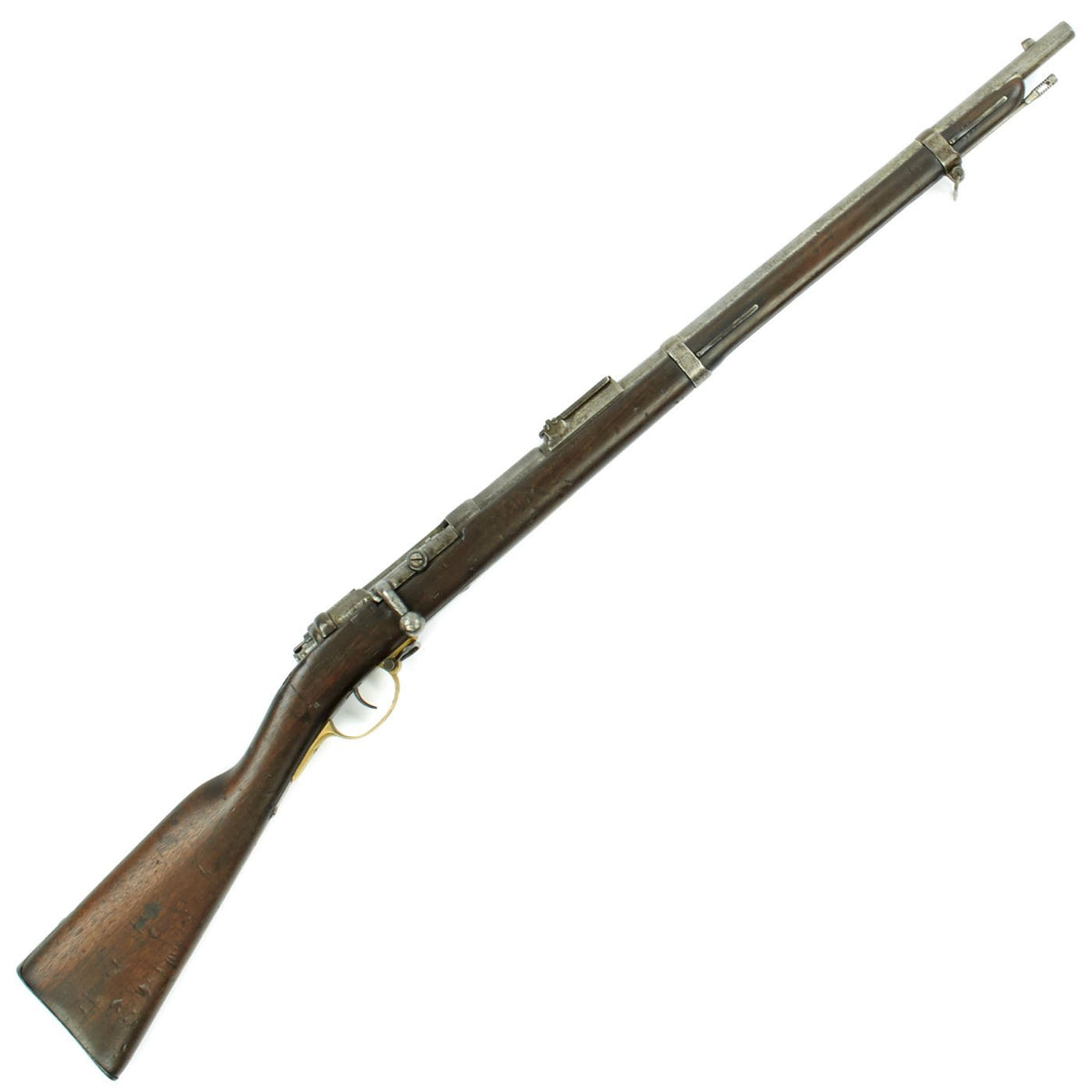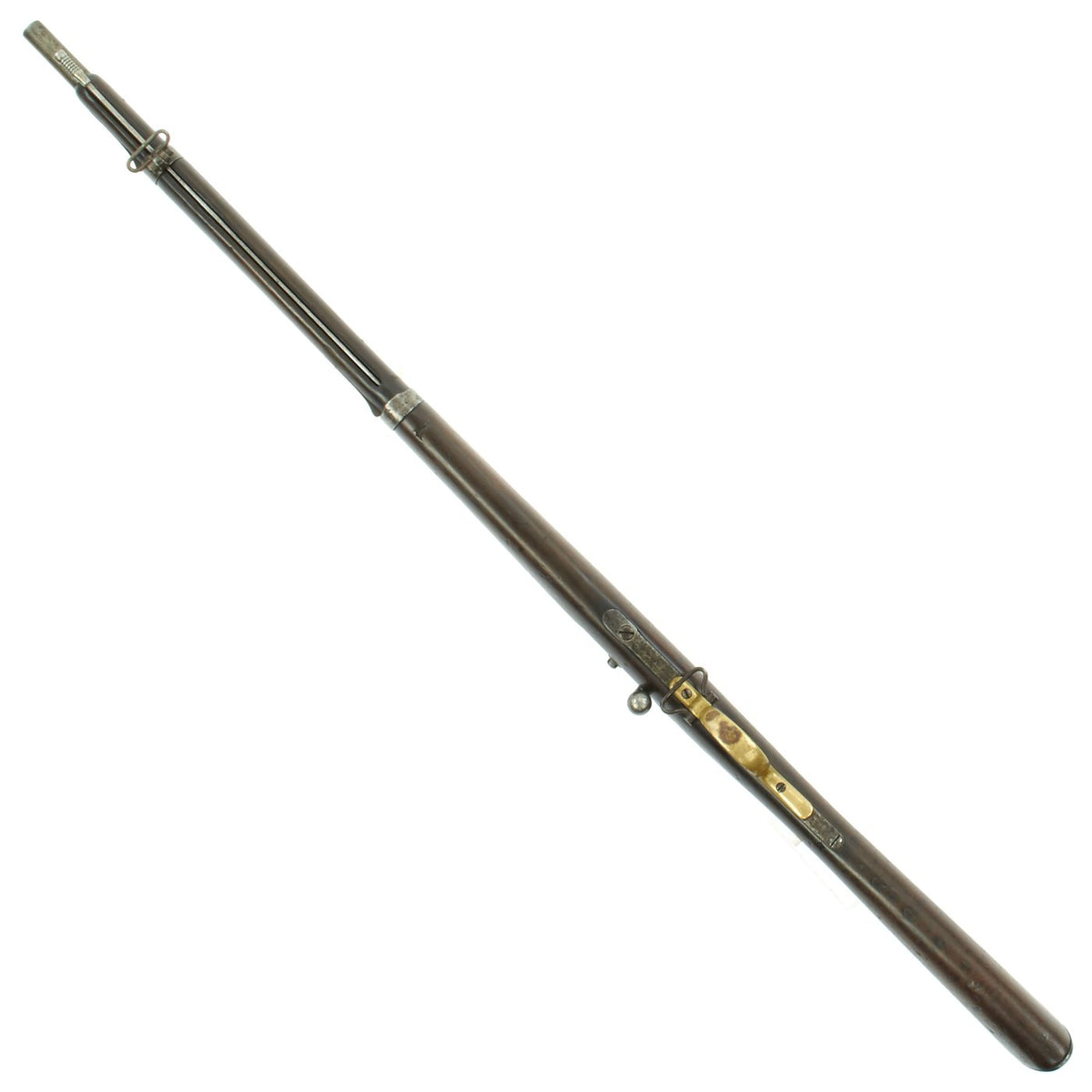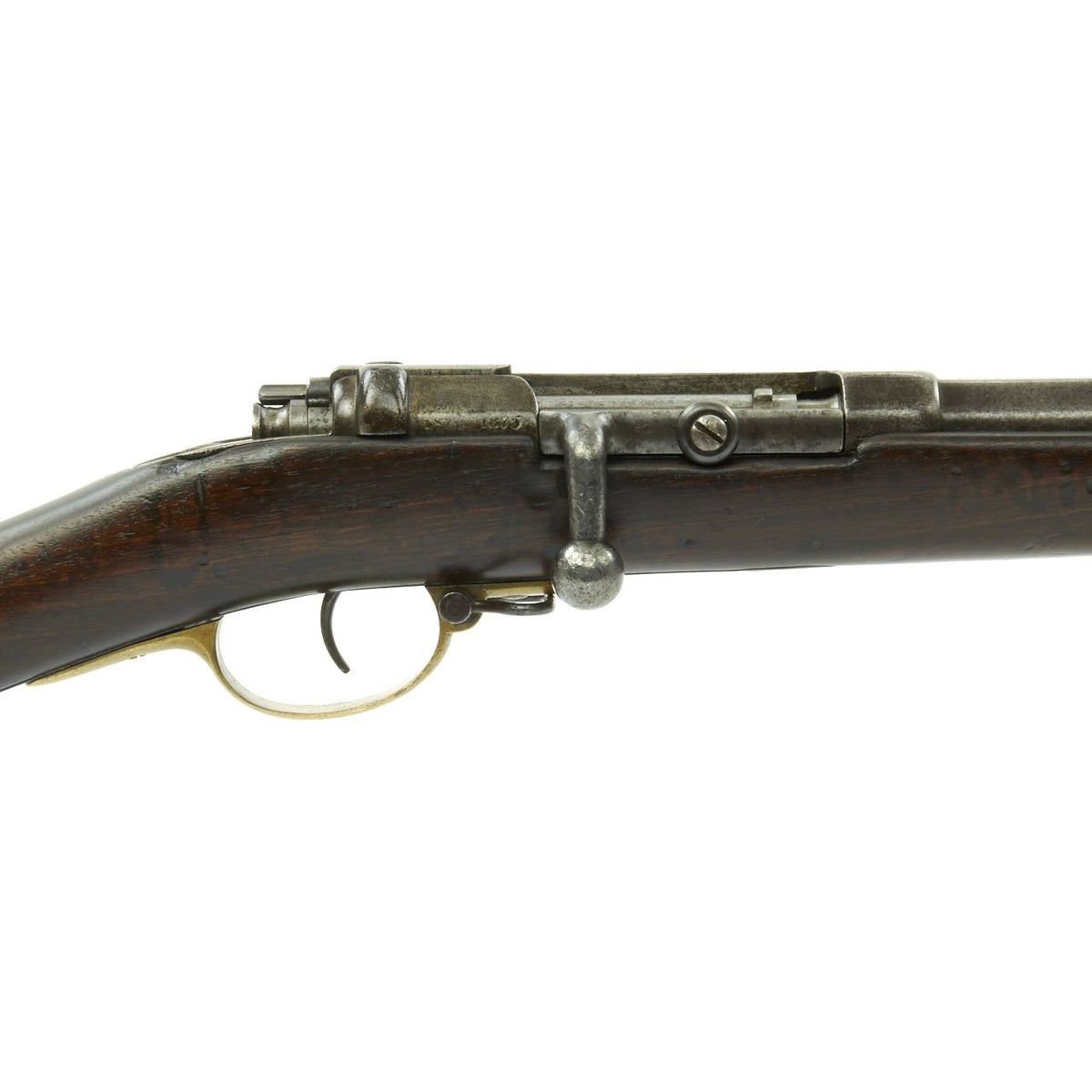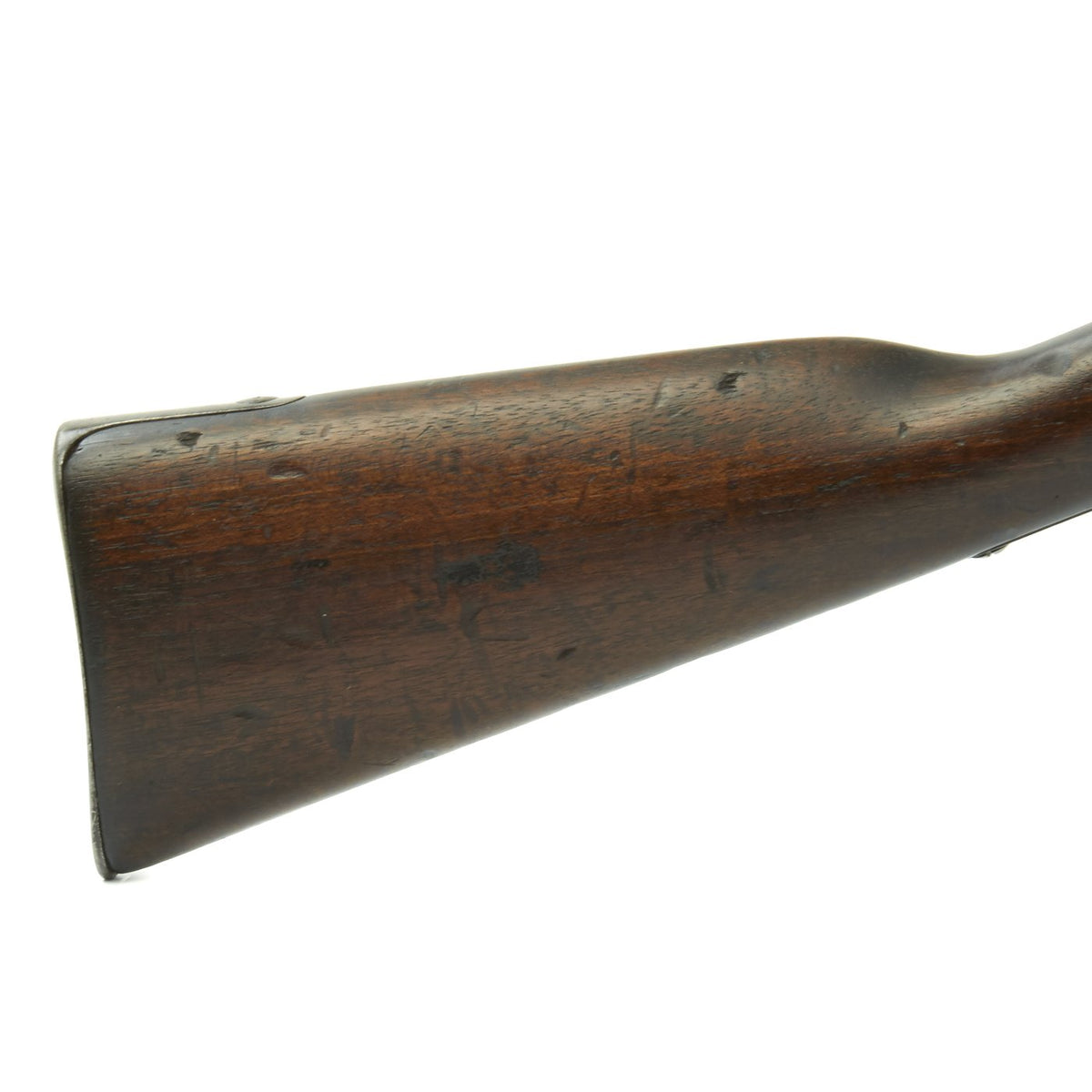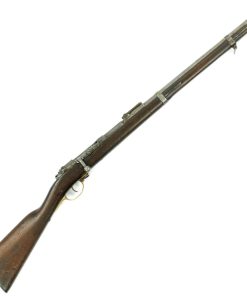Original German Mauser Model 1871 Japanese-marked Shortened Rifle by Gebr. Mauser dated 1873 Original Items
$ 795,00 $ 238,50
Original Item: Only One Available. This is a very interesting example of the Mauser Model 1871 rifle, manufactured at Oberndorf am Neckar by rare maker Gebrüder Mauser. This could be a rifle that Paul Mauser himself worked on. It has the standard Imperial German inspection and acceptance markings, even on the wood stock. These are however somewhat faint, as the metalwork and stock are quite worn.
The receiver is dated 1873 as well as 1875 behind the cocking handle, and marked I. G. Mod. 71 on the opposite side. The rifle itself has been shortened by about 8 inches overall, and the front barrel band with bayonet lug removed. It also has had the original bolt replaced with a “cavalry style” bolt with a downturned bold handle.
The wood butt stock also has been stamped with what appear to be Japanese characters on the left hand side, and we speculate that this rifle was supplied by Germany to the newly emerging Japan in the 1870s. This would mean it was possibly used in the the Satsuma Rebellion or Seinan War (Japanese: 西南戦争 Hepburn: Seinan Sensō, lit. “Southwestern War”). This was the internal Japanese War about which the TOM CRUISE made Movie of 2004 entitled “THE LAST SAMURAI” was all about: the end of the samurai class. We suspect it was then transformed to its present state for use with mounted troops.
The serial number 4637A appears on the barrel and receiver, while the other numbers are worn off or unmarked. The top of the barrel knoxform is faintly marked GEBR. MAUSER & Co OBENDORF, indicating manufacture by Gebrüder Mauser & Cie, Oberndorf-am-Neckar, in the German Kingdom of Württemberg. This is the firm, run by Wilhelm and Paul Mauser, was the one responsible for the design of the Model 1871, and many other legendary firearms.
The Rifle comes complete with cleaning rod and is in good used condition overall. The exterior metal finish is worn to a gray patina, with a lot of rounding of the markings. There is a bit of light peppering, but nothing major. The bore is in good condition, partly bright with clear land and grooves, and some wear and oxidation. Both sling swivels are present and in good shape.
Stock is also in good condition, and has a great aged look. It has the expected dents and dings from long service, but no major cracks or other issues. It does not appear to have been refinished or sanded down at all, so the stock proofs are still present, but faded from wear.
These early Mauser Rifles are hard to find especially those used by other Nations. Well worn and ready to display!
History of the Mauser 1871
Adopted as the Gewehr 71 or Infanterie-Gewehr 71, or “Infantry Rifle 71 (“I.G.Mod.71” was stamped on the rifles themselves) was the first rifle model in a distinguished line designed and manufactured by Paul Mauser and Wilhelm Mauser of the Mauser company and later mass-produced at Spandau arsenal.
Paul Mauser developed his bolt-action rifle from 1866 to 1871. During 1870-71 trials with many different rifles took place, with the “M1869 Bavarian Werder” being the Mausers’ chief competitor. The Mauser was provisionally adopted on 2 December 1871, pending the development of an appropriate safety. With support from the government’s Spandau arsenal, the improvements to the safety mechanism were completed and the rifle was formally accepted on 14 February 1872 as Infantry Rifle Model 1871 by the German Empire excluding Bavaria. The action was not based on its predecessor, the Dreyse needle gun which had seen service during the Franco-Prussian War of 1870-71, and which was found to have a number of weaknesses.
The now well known Mauser “wing” type safety lever was developed for the Gewehr 71. The Gewehr 71 is a conventional looking bolt action chambered in 11mm using black powder cartridges. The action included only a bolt guide rib as its single locking lug, locking forward of the receiving bridge. The original design was a single-shot. The design was updated in 1884 with an 8-round tubular magazine designed by Alfred von Kropatschek, making this Germany’s first repeating rifle. This version was designated the Gewehr 1871/84. A version of this repeater was adopted by the Ottoman Empire. Designated the M1887, it differentiated from the M71/84 in that it had a side mounted cleaning rod, a second locking lug on the rear of the bolt, and it was in caliber 9.5×60mmR, which Paul Mauser touted as the most efficient (black powder) cartridge. In the early 20th century a few were converted to 7.65×53mm smokeless by the arsenal in Ankara.
Specifications-
Year of Manufacture: 1873 – converted 1875
Caliber: 11x60mmR Mauser
Cartridge Type: Centerfire Cartridge
Barrel Length: 25 inches
Overall Length: 44 1/2 Inches
Action type: Bolt-Action
Feed System: Single Shot
NOTE: International orders of antique firearms MUST be shipped using UPS WW Services (courier). USPS Priority Mail international will not accept these.
Fast Shipping with Professional Packaging
Thanks to our longstanding association with UPS FedEx DHL, and other major international carriers, we are able to provide a range of shipping options. Our warehouse staff is expertly trained and will wrap your products according to our exact and precise specifications. Prior to shipping, your goods will be thoroughly examined and securely secured. We ship to thousands clients each day across multiple countries. This shows how we're dedicated to be the largest retailer on the internet. Warehouses and distribution centres can be located throughout Europe as well as the USA.
Note: Orders with more than one item will be assigned a processing date depending on the item.
Before shipping before shipping, we'll conduct a thorough inspection of the items you have ordered. Today, the majority of orders will be delivered within 48 hours. The delivery time will be between 3-7 days.
Returns
The stock is dynamic and we cannot completely manage it because multiple stakeholders are involved, including our factory and warehouse. So the actual stock may alter at any time. It's possible that you may not receive your order once the order has been made.
Our policy is valid for a period of 30 days. If you don't receive the product within 30 days, we are not able to issue a refund or an exchange.
You can only return an item if it is unused and in the same state as the day you received it. You must have the item in its original packaging.
Related products
Uncategorized
Australian WWII Owen MK1 Machine Carbine SMG Custom Fabricated Replica with Sling Original Items
Uncategorized
Uncategorized
Uncategorized
Angolan Rebel 1970s era 60mm Inert Display Mortar from Angolan Civil War Original Items
Uncategorized
Uncategorized
Uncategorized
Uncategorized
Uncategorized
Uncategorized
Armoured Fighting Vehicles of the World: AFVs of World War One (Hardcover Book) New Made Items
Uncategorized
Uncategorized
Uncategorized
Uncategorized
Uncategorized
Uncategorized
Uncategorized
Uncategorized
Uncategorized
